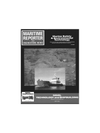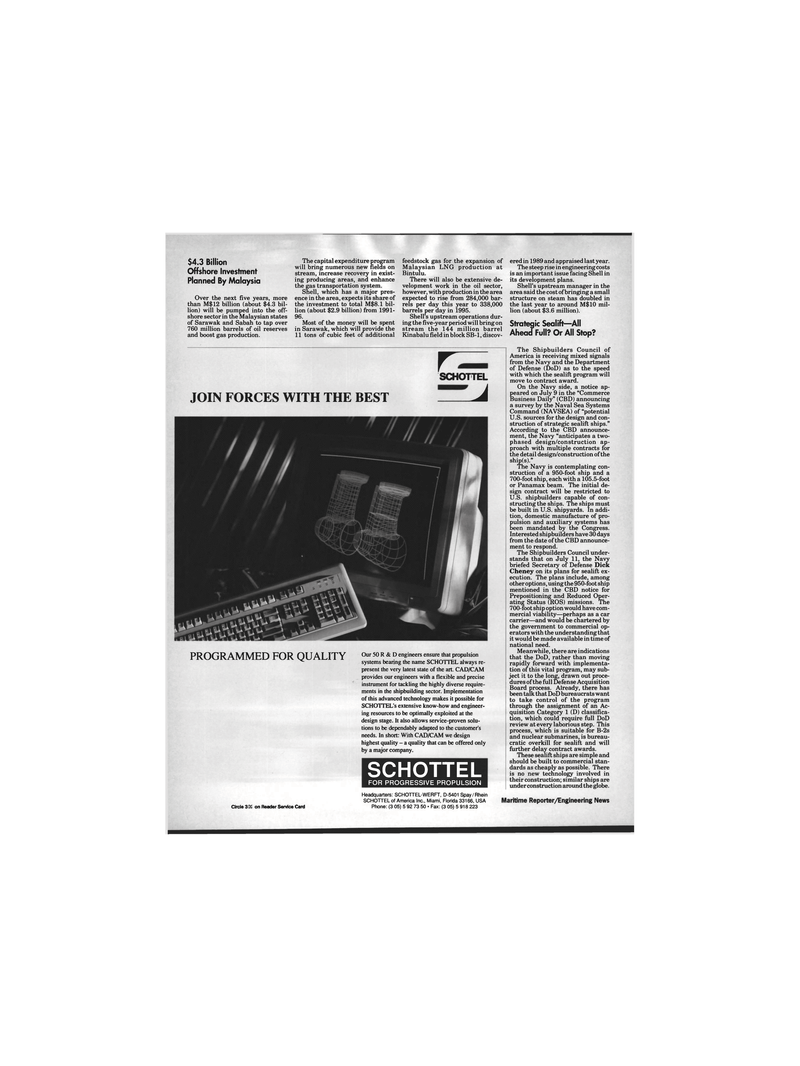
Page 7: of Maritime Reporter Magazine (September 1991)
Read this page in Pdf, Flash or Html5 edition of September 1991 Maritime Reporter Magazine
$4.3 Billion
Offshore Investment
Planned By Malaysia
Over the next five years, more than M$12 billion (about $4.3 bil- lion) will be pumped into the off- shore sector in the Malaysian states of Sarawak and Sabah to tap over 760 million barrels of oil reserves and boost gas production.
The capital expenditure program will bring numerous new fields on stream, increase recovery in exist- ing producing areas, and enhance the gas transportation system.
Shell, which has a major pres- ence in the area, expects its share of the investment to total M$8.1 bil- lion (about $2.9 billion) from 1991- 96.
Most of the money will be spent in Sarawak, which will provide the 11 tons of cubic feet of additional feedstock gas for the expansion of
Malaysian LNG production at
Bintulu.
There will also be extensive de- velopment work in the oil sector, however, with production in the area expected to rise from 284,000 bar- rels per day this year to 338,000 barrels per day in 1995.
Shell's upstream operations dur- ing the five-year period will bring on stream the 144 million barrel
Kinabalu field in block SB-1, discov- ered in 1989 and appraised last year.
The steep rise in engineering costs is an important issue facing Shell in its development plans.
Shell's upstream manager in the area said the cost of bringing a small structure on steam has doubled in the last year to around M$10 mil- lion (about $3.6 million).
Strategic Sealift—All
Ahead Full? Or All Stop?
PROGRAMMED FOR QUALITY
Circle 237 on Reader Service Card
Our 50 R & D engineers ensure that propulsion systems bearing the name SCHOTTEL always re- present the very latest state of the art. CAD/CAM provides our engineers with a flexible and precise instrument for tackling the highly diverse require- ments in the shipbuilding sector. Implementation of this advanced technology makes it possible for
SCHOTTEL's extensive know-how and engineer- ing resources to be optimally exploited at the design stage. It also allows service-proven solu- tions to be dependably adapted to the customer's needs. In short: With CAD/CAM we design highest quality - a quality that can be offered only by a major company.
SCHOTTEL
FOR PROGRESSIVE PROPULSION
Headquarters: SCHOTTEL-WERFT, D-5401 Spay/Rhein
SCHOTTEL of America Inc., Miami, Florida 33166, USA
Phone: (3 05) 5 92 73 50 • Fax: (3 05) 5 918 223
The Shipbuilders Council of
America is receiving mixed signals from the Navy and the Department of Defense (DOD) as to the speed with which the sealift program will move to contract award.
On the Navy side, a notice ap- peared on July 9 in the "Commerce
Business Daily" (CBD) announcing a survey by the Naval Sea Systems
Command (NAVSEA) of "potential
U.S. sources for the design and con- struction of strategic sealift ships."
According to the CBD announce- ment, the Navy "anticipates a two- phased design/construction ap- proach with multiple contracts for the detail design/construction of the ship(s)."
The Navy is contemplating con- struction of a 950-foot ship and a 700-foot ship, each with a 105.5-foot or Panamax beam. The initial de- sign contract will be restricted to
U.S. shipbuilders capable of con- structing the ships. The ships must be built in U.S. shipyards. In addi- tion, domestic manufacture of pro- pulsion and auxiliary systems has been mandated by the Congress.
Interested shipbuilders have 30 days from the date of the CBD announce- ment to respond.
The Shipbuilders Council under- stands that on July 11, the Navy briefed Secretary of Defense Dick
Cheney on its plans for sealift ex- ecution. The plans include, among other options, using the 950-foot ship mentioned in the CBD notice for
Prepositioning and Reduced Oper- ating Status (ROS) missions. The 700-foot ship option would have com- mercial viability—perhaps as a car carrier—and would be chartered by the government to commercial op- erators with the understanding that it would be made available in time of national need.
Meanwhile, there are indications that the DoD, rather than moving rapidly forward with implementa- tion of this vital program, may sub- ject it to the long, drawn out proce- dures of the full Defense Acquisition
Board process. Already, there has been talk that DoD bureaucrats want to take control of the program through the assignment of an Ac- quisition Category 1 (D) classifica- tion, which could require full DoD review at every laborious step. This process, which is suitable for B-2s and nuclear submarines, is bureau- cratic overkill for sealift and will further delay contract awards.
These sealift ships are simple and should be built to commercial stan- dards as cheaply as possible. There is no new technology involved in their construction; similar ships are under construction around the globe. 9 Maritime Reporter/Engineering News r
JOIN FORCES WITH THE BEST
SCHOTTEL
J

 6
6

 8
8
